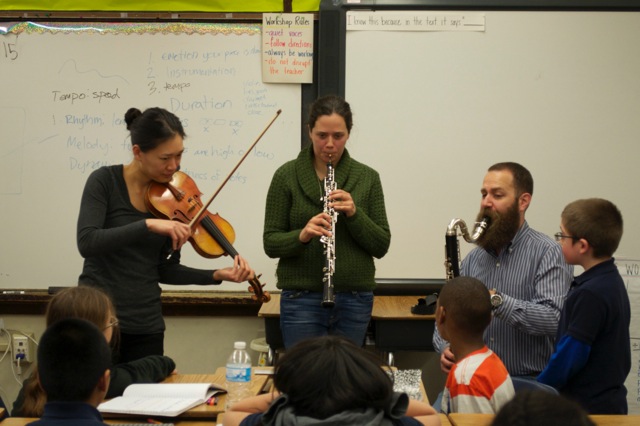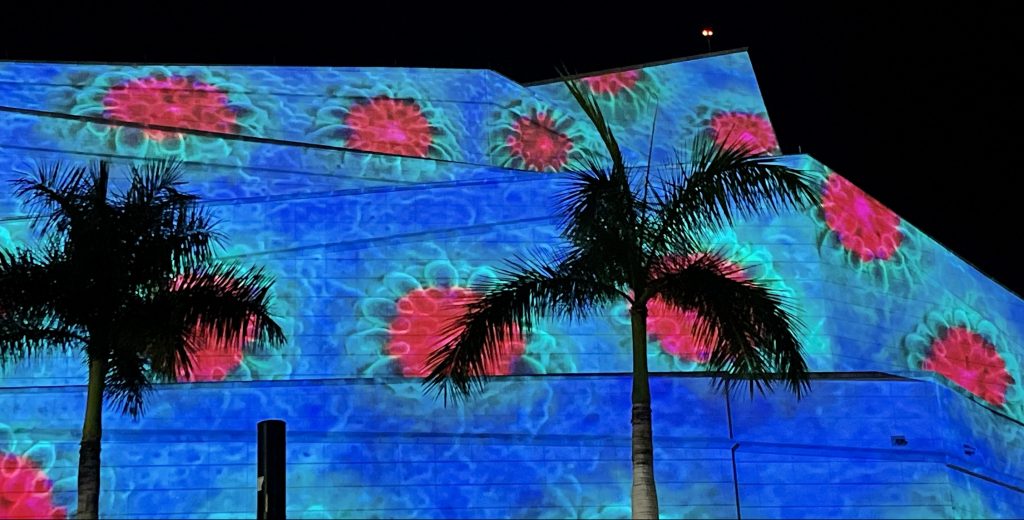
Creating Citizen-Artists with ArtistYear

Today, Knight Foundation is announcing new funding for the Curtis ArtistYear Fellowship Program, which will allow the arts-based service corps piloted by the Curtis in partnership with the Aspen Institute’s Franklin Project, to expand. Below, one of the program’s first fellows, Curtis graduate and oboe player Alexandra von der Embse, reflects on her year teaching music composition at John H. Taggart Elementary School in South Philadelphia.
I have always considered myself “socially minded.” At first, I had a vague understanding of wanting to improve the world in which I existed. In high school, this meant political activism and involvement in organizations I cared about. I spent two years volunteering at the San Francisco Public Defender’s Office and once flew to Washington, DC from San Francisco to attend a protest for women’s rights. Because I couldn’t miss youth orchestra rehearsal on Saturday, or school on Monday, I flew there and back on the same day. Although I have always believed music is an honorable endeavor that does improve the world, the part of my life engaged with causes I cared about seemed as if it belonged to another world as I found myself delving deeper into my passion for music.

Alexandra von der Embse.
The Curtis Institute of Music’s former Executive Vice President Elizabeth Warshawer approached me in the early stages of ArtistYear. As soon as she described it – as a way to create a year of service for artists – I jumped at the opportunity. It was becoming harder for me to justify a career where I felt I had to separate my desire to create meaningful change in the world from my dedication to performing music at the highest level. When I was introduced to Margo Drakos, Curtis alum and co-founder of ArtistYear, I was deeply inspired by her life as an artist with an innate sense of social responsibility. A cellist turned technology entrepreneur, she questioned whether instead of asking what communities could do to support the arts, we could ask what artists could do to support their communities.
For my own work with ArtistYear, I was drawn to the Philadelphia Public School District because of students’ increasingly limited access to music. I thought about my own education and how music had influenced it. I was never a particularly studious pupil but I loved school, and I learned to think. Having ownership of a project, the confidence of creation and constantly striving to improve to the levels of leaders in my field (I knew they had practiced hours upon years to reach the levels that moved me, and I could one day get there too) gave me a need to learn everything I could.
After choosing Taggart Elementary for my project, I had to figure out how I could best serve the students there. (I knew creating 25 new oboe players wasn’t the answer!) I asked Founding Director of the Curtis ArtistYear Fellowship Program David Ludwig (a composer, dean of artistic programs, and a mentor of mine) how I could get the students to create and experience music at a high level without being limited by the need to read music or master an instrument. He suggested teaching students to compose.
During this first pilot year of the fellowship, I created a curriculum that taught fourth graders how to compose music with non-traditional graphic notation that uses lines and shapes to visually describe sounds. With this fundamental concept of composition as a starting off point, I had the opportunity to teach these students about the individual elements of music – rhythm, melody, tempo, dynamics and articulation – and explore them in significant ways without any prior musical training. In addition to teaching them to perform and rehearse their own works on hand percussion and created instruments, I brought in many colleagues – members of Grammy Award-winning eighth blackbird, the BOK Trio (of ArtistYear fellows), and other Curtis musicians – to perform their music for them. Our instruments seemed that much cooler when the sound we were making came from students’ creations. They now had access and full license to create and perform music, as well as to listen in new ways.
I also wanted to expose students to the rich arts culture in their home city of Philadelphia. I brought the class to the Pennsylvania Ballet to watch the dancers and participate in a short class themselves. In May, we attended a LiveConnections Bridge Session at World Cafe Live with the Al-Bustan Takht Ensemble and Jason Vieux. As a follow-up to the ballet visit, a dancer in the second company came to their school and showed them another kind of dance.
A significant reason my project was impactful this year was the involvement and support of the fourth grade and music teachers at Taggart. Both were incredibly helpful, allowing me to observe them teach, assisting me with my lesson plans, and coaching me in classroom management while I taught. I realized quickly what I didn’t know how to do, but because of their help, these shortcomings did not hold back my program’s impact. This was a great supplement to my work with Mary Javian, faculty and Director of Professional Development and Community Engagement at Curtis, who shared many lesson plans, readings, and experiences as a teaching artist.
Now, as the first year of the ArtistYear Fellowship Program comes to a close, I have the unique opportunity of gearing up for my second. In deciding why exactly I wanted to serve for a second year, I had to consider the ways I wanted to move forward as an individual and the ways in which I envisioned the program might evolve from the foundation our founding team has created. A recent retreat with the Aspen Institute prompted us to reflect on the year and consider our relationship and similarities to other existing service programs.
Drawing upon my experiences from year one, I am adjusting my curriculum to teach composition to all ages. Instead of having one project home in one location, as I did this year at Taggart Elementary, my project will be based in a performance series set in a variety of locations. Each engagement residency, whether it be in schools, retirement communities, juvenile detention facilities or homeless shelters, will culminate in a performance and include a commission by a Curtis composer. These new compositions will be inspired by members of the communities we are serving to tell their stories through music.
Next year, I will collaborate with existing organizations that already have relationships with the communities I want to reach. The greatest lesson I took from this year is that, to serve effectively, one must first ask what is needed. As with music, this is a skill that I hope to spend my life mastering. The path to finding this answer is a lifelong journey. By working with and learning from people who have learned more about how to ask that question, I hope to deepen the impact of sharing this art that I care so passionately about with people whose lives could be enriched through music.
Recent Content
-
Artsarticle ·
-
Artsarticle ·
-
Artsarticle ·
